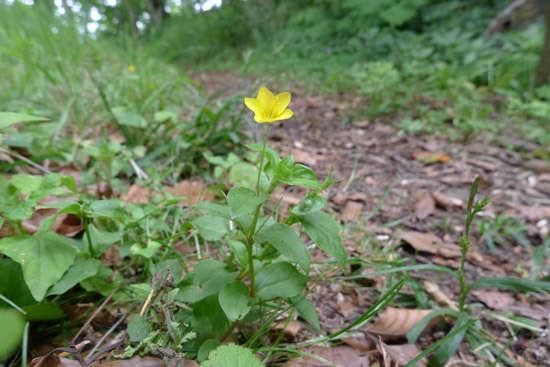
How to Tell the Difference Between Chickweed and Yellow Pimpernel

Yellow pimpernel, Lysimachia nemora, is a small hairless plant, with leaves of a similar shape and size to those of Common Chickweed, Stellaria media. Common Chickweed is an edible wild green that I have written about in a previous article. Chickweed is easily recognised when its small white flowers are present, less so when they are not. Yellow Pimpernel is an inedible/mildly toxic plant that can be mistaken for Chickweed. Again, when Yellow Pimpernel’s pretty yellow flowers are present, the plant is relatively easy to recognise (and differentiate from Chickweed). When neither plant’s flowers are present, however, then we need to look for other differentiators.

When neither Chickweed nor Yellow Pimpernel is in flower, the key differentiating feature we need to note is that while Yellow Pimpernel is hairless, Common Chickweed has a single line of hairs on its stem.


As long as you stick to this key differentiating feature of a line of hairs on the stem to positively identify Common Chickweed, then you will avoid Yellow Pimpernel.
Best Practice while Foraging
Please read the BSBI’s Code of Conduct for the Conservation and Enjoyment of Wild Plants for guidance on the best practice (and UK laws) relating to foraging for wild plant foods.
Disclaimer
This article is meant only as a guide and is largely a record of my recent forages. It is not a complete treatment of all edible plants that might be available. Nor does it provide a complete treatment of all poisonous plants that may also be present in the habitat where you find the above-mentioned plants. If you want to learn more about plant identification you should invest in some good field guides. The safest way to learn about edible wild plants is for someone who already has the knowledge to show you in person. Any foraging you do on your own is at your own risk.
The most important thing to remember when identifying wild foods is:
IF IN DOUBT, LEAVE IT OUT!
Recommended Field Guides:
Collins Wild Flower GuideCollins Complete (Photographic) Guide To Wild FlowersThe Wild Flower Key
Related Articles on Paul Kirtley’s Blog
Foraging for Early Spring Greens: Some to Eat, Some to Avoid…
Brooklime, Veronica beccabunga
Primrose, Primula vulgaris: Wild food?
8 thoughts on “How to Tell the Difference Between Chickweed and Yellow Pimpernel”
Brilliant, simple and clear, cheers matey!
That’s so simple :o)
Thanks Dave and Steve
Where possible, simple and clear is what I aim for.
All the best
Paul
chickweed and scarlet pimpernel grow side by side on my allotment – this will also help me weed out one and leave the other before the flowers appear. Top Tip
Hi Deggie,
Thanks for your comment. Glad this was useful to you 🙂
All the best,
Paul
Excellent article, the dandelion, being an endive similar I guess to chickory is a very useful plant. All parts are edible and this one goes against the survivalists’ grain to avoid plants with a white sap. Flowers tart up a salad, the roots can be boiled and even used to make coffee. Careful where you source them tho. Dog’s aren’t fussy and apparently the taste is as strong as the smell!
The way you’ve broken down the differences between chickweed and yellow pimpernel is incredibly helpful for anyone interested in foraging or botany. Your detailed descriptions of their distinct features, from leaf shape to flower characteristics, make it easy for readers to identify these plants in the wild. I love how you’ve included tips for differentiating them in various environments, which adds even more practical value. This guide is an excellent resource for nature enthusiasts and outdoor explorers alike!
Thank you!